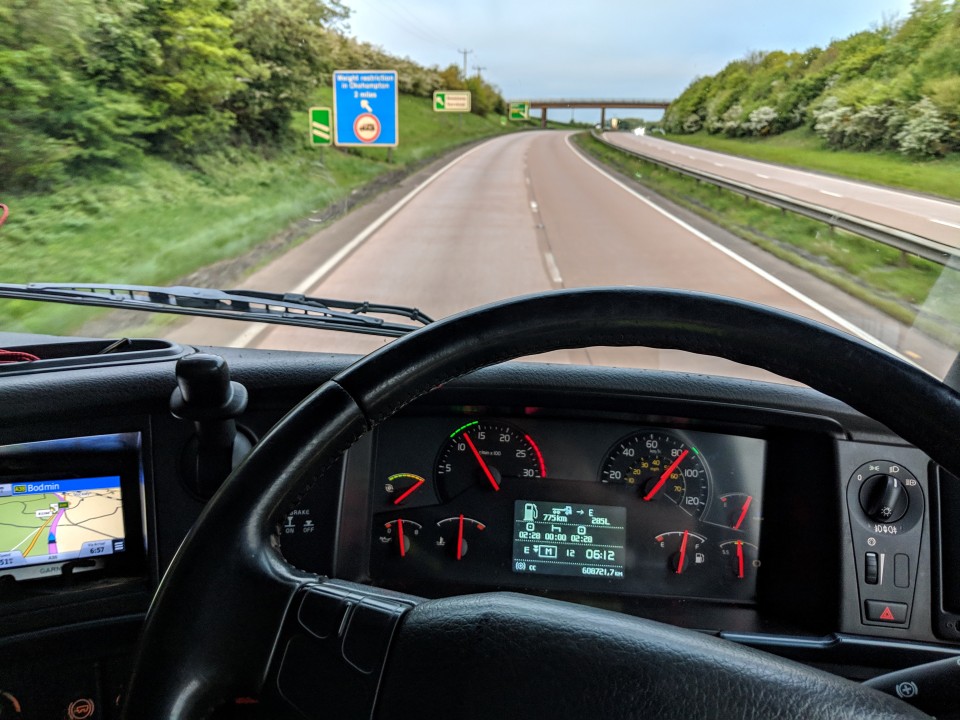
Susie Jones
Está aborrecido na estrada?
Criado: 27/08/2024
•
Atualizado: 27/08/2024
O camionista médio passa cerca de 12 horas ao volante todos os dias. O tempo sem fim na estrada pode parecer apelativo, no entanto, a realidade é um contraste gritante. Inúmeras estações de serviço, áreas de descanso e longas horas podem tornar-se aborrecidas. Os camionistas passam frequentemente o seu tempo de inatividade longe de casa e evitar o tédio pode ser um desafio.
Um inquérito recente da Convoy sugeriu que o tédio era um dos principais desafios dos camionistas. Que efeito está o tédio a ter no bem-estar dos condutores? E como podem os camionistas manter-se entretidos?
Como o tédio afecta o bem-estar dos condutores
A fadiga, o isolamento, a solidão e a falta de estímulo mental são preocupações comuns dos condutores. Alguns condutores podem lidar com estas preocupações através de mecanismos de sobrevivência pouco saudáveis - como comer em excesso, fumar ou consumir cafeína em excesso. Com o tempo, estes hábitos podem afetar negativamente a saúde mental.
No entanto, à medida que se fala mais sobre a saúde mental, cada vez mais condutores estão a seguir um caminho diferente para a combater. Perguntámos aos condutores de camiões no Facebook o que fazem quando o tédio aparece.
"Audiolivros, sobretudo de psicologia. Música, conversar com pessoas queridas ou ouvir rádio. Ou desligo tudo e tenho uma existência pacífica com os meus próprios pensamentos", diz Nigel.
Outros referiram que falar com os seus entes queridos por telefone ajudou. Ashleigh afirma:
"Falar com os meus amigos numa conversa de grupo. Sinceramente, se não os tivesse, já teria desistido há muito tempo. A estrada é um lixo e, sem falar com bons amigos, nunca teria sobrevivido."
Da mesma forma, Karl acredita que uma "conversa de grupo com amigos é obrigatória".

Evitar o tédio ao volante
Contrariamente à crença popular, a atividade de camionista é uma atividade física - os condutores precisam de coordenação e concentração para evitar acidentes. Apesar disso, estar ao volante durante longos períodos de tempo pode causar fadiga. O risco de se tornar complacente no trabalho pode ocorrer, especialmente se o condutor conhecer bem a sua rota. Como é que os condutores podem lidar com a complacência ao volante?
Quer se trate de ouvir um podcast ou uma música cativante, os condutores devem escolher algo que mantenha a sua mente alerta. Compilámos uma lista de coisas para evitar o tédio ao volante.
Podcasts: O camionista Marty ouve "dezenas de podcasts" enquanto conduz. Os podcasts são uma excelente forma de mudar as coisas e aprender algo novo. Veja esta [lista útil de podcasts sobre camionagem] (https://www.alltruckjobs.com/blog/trucking-podcasts-better-radio/)
Música: "Música, música e música" é o quebra-galho do Richard. Quer seja a ouvir rádio ou a cantar ao som de uma lista de reprodução, a música é uma excelente forma de manter a mente alerta
Fazer uma pausa: Embora os condutores tenham de cumprir prazos rigorosos e cumprir os regulamentos do tacógrafo, sair da cabina quando o tédio aparece ajuda a mente a concentrar-se.
Tédio durante o tempo de inatividade
Os camionistas enfrentam desafios adicionais para se entreterem após o seu turno. É imperativo adotar uma abordagem proactiva para evitar o tédio durante este período. Compilámos uma lista de formas de passar as horas.
Localização: As paragens de camiões que oferecem uma vasta gama de instalações e uma sensação de comunidade são uma excelente forma de aliviar o tédio. Algumas funcionam como um centro social onde os camionistas podem partilhar experiências semelhantes. Visite a nossa [página de localizações] (https://www.snapacc.com/locations/?lang=EN) para ver que instalações os nossos parceiros de serviços SNAP oferecem
Exercício físico: Fazer uma caminhada diária ou ser criativo com os seus exercícios pode evitar o tédio e garantir que se mantém em forma e saudável. Veja as nossas dicas para se manter saudável na estrada
Serviços de streaming: Ver o último programa de televisão ou percorrer as redes sociais. O camionista Steve gosta de "navegar e comentar no Facebook e ver Netflix" para passar o tempo
Passatempos: As oportunidades são infinitas. Aprender um instrumento, aprender uma língua estrangeira, desenhar, escrever e muito mais. Escolher um passatempo é uma forma eficaz de evitar o tédio
Cozinhar: Cozinhar refeições no táxi tem muitas vantagens. Não só evita o tédio, como também poupa dinheiro e é mais saudável
Manter-se em contacto com os entes queridos: O tempo de inatividade de um camionista é a oportunidade perfeita para contactar os que lhe são mais próximos. As videochamadas são uma forma eficaz de se sentir mais próximo da família e dos amigos
Relaxar: Os camionistas podem enfrentar situações de stress. Relaxar totalmente após um turno pode melhorar o bem-estar do condutor. As técnicas de relaxamento, como os exercícios de respiração profunda e a meditação, reduzem o stress.
Embora alguns condutores apreciem a solidão e a independência que a estrada aberta oferece, combater o tédio continua a ser um desafio para muitos. Devido à natureza do trabalho, os camionistas passam frequentemente por longos períodos de tédio. No entanto, para melhorar o bem-estar, a satisfação profissional e a segurança rodoviária, têm de encontrar formas de o aliviar. Quer se concentrem na tarefa que têm em mãos, ouçam rádio ou conversem com amigos e familiares, a maioria dos camionistas consegue encontrar uma solução que funciona para eles.

Onde dormem os condutores de camiões?
A maioria dos condutores dorme nas suas cabinas, uma vez que estas estão bem equipadas para uma noite de sono confortável. Uma cabina-cama básica inclui uma cama, arrumação, luzes e tomadas eléctricas - o que a torna uma casa longe de casa.
Devido à atual falta de estacionamento na Europa, muitos condutores estacionam nas bermas. Esta prática é considerada insegura e deixa o condutor vulnerável a roubos. A partir de novembro de 2017, os condutores de veículos pesados no Reino Unido devem fazer pausas semanais regulares em áreas de repouso adequadas (como áreas de serviço e paragens de camiões).
O esquema [SNAP's Depot Parking] (https://snapacc.com/depot-parking) permite que as frotas ofereçam os seus lugares de estacionamento para camiões à rede, aliviando a escassez e ajudando os condutores a evitar situações vulneráveis. Além disso, a SNAP disponibiliza mais de 450 parceiros de serviços em toda a Europa para os condutores estacionarem. Visite a nossa [página de mapas] (https://snapacc.com/map/) para saber mais.
Porque é que os condutores de camiões deixam as portas dos reboques abertas?
Se alguma vez conduziu por uma estrada principal à noite, pode ter reparado em camiões estacionados com as portas dos reboques abertas. Muitos condutores fazem-no para dissuadir os ladrões, partindo do princípio de que, se a porta do reboque estiver aberta, não há nada para roubar. Isto é feito predominantemente em reboques com cortinas laterais, pois evita que os ladrões cortem a cortina para ver o que está lá dentro.



